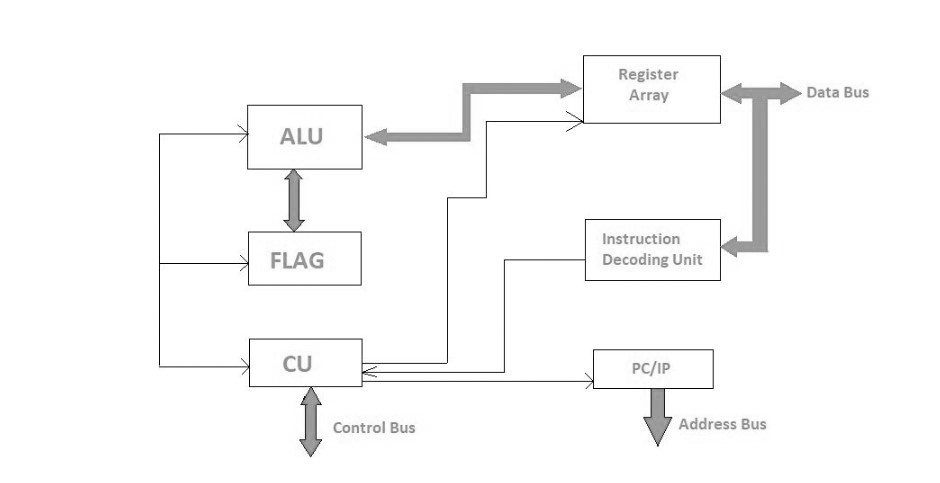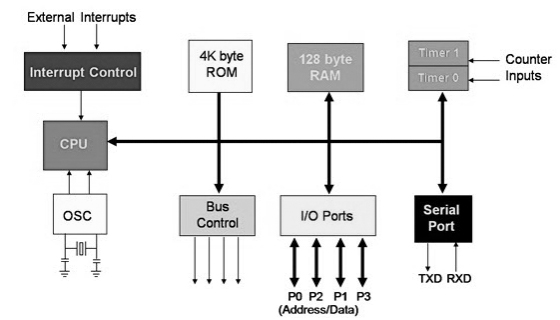Time: 2024-02-20 16:40:13View:
Microcontrollers are compact computer systems that are specifically designed to carry out designated tasks. They integrate key computer components like a processor, memory, input/output peripherals, and a clock onto a single chip. These devices are extensively utilized in a variety of electronic gadgets and systems, from basic household appliances to intricate industrial equipment.
One of the primary features of microcontrollers is their capability to follow a predetermined set of instructions to manage the functions of a device or system. These instructions, also referred to as firmware or embedded software, are stored in the microcontroller's memory and are typically coded in low-level programming languages like C or assembly language.
Microcontrollers are recognized for their small size, low energy consumption, and cost efficiency. They are tailored for embedded applications, where they are incorporated into the device or system they regulate. This close integration enables seamless communication between the microcontroller and the hardware it interacts with, facilitating precise and effective control over the device's operations.
These devices provide a diverse array of input/output choices to interact with the external environment. These options may include digital and analog inputs for receiving signals from sensors, digital and analog outputs for managing actuators and displays, communication interfaces like UART, SPI, I2C, and Ethernet for data transfer, as well as timers and counters for accurate timing and event recording.
For more information, please read this article: An Overview of Microcontroller
Microprocessors are the central processing units (CPUs) of computers and other digital devices. They are the core components responsible for executing instructions and performing calculations in a computer system. Unlike microcontrollers, which are self-contained systems, microprocessors are designed to work in conjunction with other hardware components to form a complete computer system.
At their core, microprocessors are integrated circuits (ICs) that contain millions or billions of transistors. These transistors are interconnected to form complex circuits that can perform arithmetic, logical, and control operations. The main function of a microprocessor is to fetch, decode, and execute instructions stored in the computer's memory.
Microprocessors are highly versatile and can be found in a wide range of devices, from personal computers and laptops to smartphones, tablets, gaming consoles, and servers. They are also used in various industrial applications, embedded systems, and appliances where high-performance computing is required.
The architecture of a microprocessor defines its organization, instruction set, and features. Some well-known microprocessor architectures include x86, ARM, MIPS, PowerPC, and RISC-V. Each architecture has its own set of instructions and capabilities, and different manufacturers produce microprocessors based on these architectures.
Microprocessors rely on external components to perform input/output operations and interact with the external environment. These components include memory modules (RAM and ROM), storage devices (hard drives, solid-state drives), input devices (keyboard, mouse), output devices (display, printer), and various communication interfaces (USB, Ethernet, HDMI, etc.).
One of the defining features of microprocessors is their ability to execute a wide range of software applications. They rely on operating systems and software programs to provide a user-friendly interface and perform specific tasks. Operating systems manage resources, coordinate tasks, and provide services to applications, while software programs perform specific functions such as word processing, image editing, or gaming.
Microprocessors have evolved rapidly over the years, leading to significant increases in computing power and efficiency. Manufacturers continually strive to develop processors with higher clock speeds, more cores, and improved power efficiency. This progress has enabled the development of advanced technologies such as artificial intelligence, virtual reality, and machine learning, which heavily rely on powerful microprocessors to perform complex computations.
In summary, microprocessors are the central processing units of computers and digital devices. They execute instructions and perform calculations to carry out various tasks. Microprocessors work in conjunction with other hardware components, rely on software programs and operating systems, and come in different architectures. They are highly versatile and have facilitated the development of diverse computing applications across various industries.
Here's a table comparing microcontrollers and microprocessors:
Feature | Microcontrollers | Microprocessors |
Integration | Self-contained systems with CPU, memory, and peripherals integrated into a single chip | CPU component that requires external components for memory, peripherals, and I/O |
Typical Applications | Embedded systems, consumer electronics, industrial automation, IoT devices | Personal computers, laptops, servers, smartphones, gaming consoles, etc. |
Instruction Set | Usually simpler and optimized for specific tasks, often with reduced power consumption | More complex and versatile instruction sets and architectures |
I/O Capabilities | Designed with specific I/O peripherals (analog, digital, communication interfaces) | Relies on external components for I/O, memory, storage, and I/O |
Power Consumption | Low power consumption, optimized for energy efficiency in battery-powered devices | Power consumption can vary, with some processors designed for high performance |
Development Tools | Often provided with development boards,IDEs, libraries, and community support | Wide range of development tools, software frameworks, and extensive support |
Cost | Generally lower cost due to integrated components and targeted applications | Cost can vary depending on performance and features |
Real-time Capabilities | Often designed with real-time operating systems (RTOS) in mind for time-critical tasks | Typically not designed with real-time constraints in mind |
Examples of Families | Arduino, PIC, AVR, MSP430 | x86, ARM, MIPS, PowerPC, RISC-V |
Microprocessor Architecture:
The architecture of a microprocessor refers to the organization and design of its internal components and how they interact to execute instructions. Here are the key components typically found in a microprocessor architecture:
1. Control Unit (CU): The control unit manages the execution of instructions. It fetches instructions from memory, decodes them, and initiates the required operations.
2. Arithmetic Logic Unit (ALU): The ALU performs arithmetic and logical operations such as addition, subtraction, AND, OR, and comparison operations. It operates on data stored in registers.
3. Registers: Registers are small, high-speed memory locations within the microprocessor. They hold data and instructions during processing. Common types of registers include the program counter (PC), which holds the address of the next instruction to be fetched, and general-purpose registers (e.g., accumulator, index registers) for temporary data storage.
4. Instruction Set Architecture (ISA): The ISA defines the set of instructions that the microprocessor can execute. It includes the opcode (operation code) and addressing modes that determine how operands are accessed.
5. Memory Interface: The memory interface connects the microprocessor to external memory devices, such as RAM and ROM. It handles data transfer between the processor and memory.
6. Bus System: The bus system consists of data buses, address buses, and control buses. Data buses transfer data between the processor and memory or peripherals. Address buses carry the address information for memory or I/O operations. Control buses manage the timing and control signals for various components.
A typical Microprocessor structure looks like this.

Microcontroller Architecture:
Microcontroller architecture is similar to microprocessor architecture but is designed specifically for embedded systems. Here are the key components typically found in microcontroller architecture:
1. CPU Core: The CPU core includes the control unit, ALU, and registers. It performs the instruction execution and data processing tasks.
2. Memory: Microcontrollers have built-in memory, including ROM (Read-Only Memory) for storing firmware or program code and RAM (Random Access Memory) for data storage during program execution. Some microcontrollers also have EEPROM (Electrically Erasable Programmable Read-Only Memory) for non-volatile data storage.
3. Peripherals: Microcontrollers integrate various peripherals to interact with the external world. These can include digital and analog I/O ports, timers/counters for precise timing, UART (Universal Asynchronous Receiver-Transmitter) for serial communication, SPI (Serial Peripheral Interface) and I2C (Inter-Integrated Circuit) for interfacing with other devices.
4. Clock Generator: Microcontrollers have an internal clock generator to provide the necessary timing for instruction execution and peripheral operations.
5. Power Management: Embedded systems often have specific power requirements. Microcontrollers may include power management features such as sleep modes, low-power modes, and interrupt-based wake-up to optimize power consumption.
7. Development Tools: Microcontrollers come with development tools such as Integrated Development Environments (IDEs), compilers, debuggers, and programming interfaces to facilitate software development and debugging.
Taking the internal architecture of 8051 Microcontroller as an example:

The architecture of microprocessors and microcontrollers can vary significantly depending on the specific model, manufacturer, and intended application. Different families and generations of microprocessors and microcontrollers may have different features, instruction sets, performance levels, and power consumption characteristics. Designers choose the appropriate architecture based on the requirements of the target application, balancing factors like performance, power consumption, cost, and available resources.
Microprocessor Applications:
Microprocessors find applications in a wide range of computing devices, from personal computers to high-performance servers. Here are some key areas where microprocessors are commonly used:
1. Personal Computers: Microprocessors form the core of personal computers (PCs). They handle tasks such as running operating systems, executing applications, and managing input/output operations. Microprocessors with multiple cores are used to improve multitasking and overall system performance.
2. Laptops and Mobile Devices: Microprocessors power laptops, tablets, smartphones, and other mobile devices. These processors are designed for energy efficiency to prolong battery life while delivering sufficient processing power to handle multimedia, web browsing, gaming, and other mobile applications.
3. Servers and Data Centers: Microprocessors are crucial components in servers and data centers, where they handle complex computations, data storage and retrieval, virtualization, and network communication. High-performance processors with multiple cores and advanced features enable efficient data processing in cloud computing and large-scale server environments.
4. Gaming Consoles: Microprocessors play a vital role in gaming consoles, providing the computational power needed for realistic graphics rendering, physics simulation, and immersive gameplay experiences.
5. Embedded Systems: Microprocessors are extensively used in embedded systems, where they control and monitor specific functions in various devices. They are found in automotive systems, home appliances, industrial automation, medical devices, and consumer electronics. Embedded microprocessors are often optimized for low power consumption, real-time operation, and specific application requirements.
Microcontroller Applications:
Microcontrollers are specifically designed for embedded systems, where they perform dedicated functions and control various devices. Here are some common areas where microcontrollers are widely used:
1. Internet of Things (IoT): Microcontrollers are the backbone of IoT devices, enabling connectivity, data acquisition, and control in smart homes, wearable devices, environmental monitoring systems, and industrial IoT solutions. They integrate sensors, actuators, and communication interfaces to enable IoT device functionality.
2. Automotive Systems: Microcontrollers are extensively used in automotive applications, controlling functions such as engine management, climate control, safety systems (like airbags and ABS), infotainment systems, and advanced driver-assistance systems (ADAS). They provide real-time processing, precise control, and reliable operation in harsh automotive environments.
3. Home Automation: Microcontrollers are at the heart of home automation systems, controlling lighting, HVAC systems, security systems, and smart appliances. They enable remote control, energy management, and integration with voice assistants and mobile applications.
4. Medical Devices: Microcontrollers are vital components in medical devices, including patient monitoring systems, infusion pumps, pacemakers, and diagnostic equipment. They ensure precise control, accurate measurements, and reliable operation in medical applications.
5. Industrial Automation: Microcontrollers play a significant role in industrial automation, controlling machinery, robotics, process control systems, and monitoring sensors. They provide real-time control, connectivity, and integration with industrial networks.
6. Consumer Electronics: Microcontrollers are found in a wide range of consumer electronics devices, including digital cameras, smart TVs, home audio systems, gaming peripherals, and remote controls. They enable user interfaces, device control, connectivity, and interaction with various multimedia components.
The applications of microprocessors and microcontrollers are extensive and diverse, serving as the foundation for modern computing, communication, and control systems in various industries and domains.